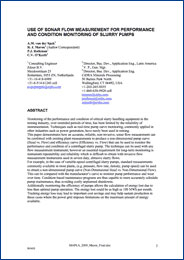2009 MAPLA • SONAR Flow Measurement for Monitoring of Pumps and Hydrocyclones
Use of SONAR Flow Measurement for Performance and Condition Monitoring of Pumps and Hydrocyclones
Monitoring of the performance and condition of critical slurry handling equipment in the mining industry, over extended periods of time, has been limited by the reliability of instrumentation. Techniques such as real-time pump curve monitoring, commonly applied in other industries such as power generation, have rarely been used in mining.
This paper demonstrates how an accurate, reliable, non-invasive, sonar flow measurement can be combined with existing plant measurements to produce a non-dimensional pump curve (Head vs. Flow) and efficiency curve (Efficiency vs. Flow) that can be used to monitor the performance and condition of a centrifugal slurry pump. The technique can be used with any flow measurement instrument; however an essential requirement for long-term monitoring is instrument repeatability and reliability which is difficult to obtain with invasive flow measurement instruments used in severe duty, abrasive slurry flows.
For example, in the case of variable-speed centrifugal slurry pumps, standard measurements commonly available in most plants, (e.g. pressure, flow rate, density, pump speed) can be used to obtain a non-dimensional pump curve (Non-Dimensional Head vs. Non-Dimensional Flow). This can be compared with the manufacturer’s curve to monitor pump performance and wear over time. Condition-based maintenance programs are thus capable to more accurately schedule pump maintenance, thus avoiding costly unplanned shutdowns.
Additionally monitoring the efficiency of pumps allows the calculation of energy lost due to less than optimal pump operation. The energy lost could be as high as 100 MWh per month. Tracking energy loss may lead to important cost savings and may help sustain production in those cases where the power grid imposes limitations on the maximum amount of energy available.

